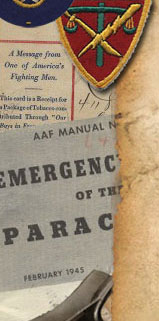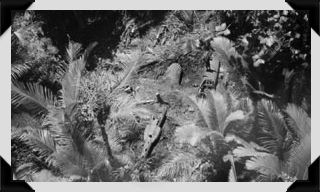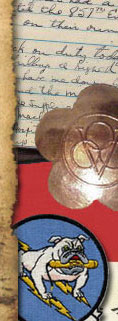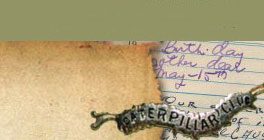

P-38 Lightning
Pilot Captain Charles P. Sullivan, Eureka, IL
Crashed September 20, 1943 (survived).
One of sixteen 39th FS P-38s that took off from 14-Mile Drome to escort B-24s on a mission against Wewak. Sullivan was leading a four-plane flight. South of the target at 24,000', Sullivan experienced engine trouble and was about to abort. Turning back for base, his engine returned to normal, and rejoined the squadron, but spotted an enemy fighter behind him that opened fire.
Charles Sullivan recalls:
"I looked into my rearview mirror and saw an unmistakable image: that of a Japanese fighter in firing position. He was so close I didn't bother to look over my shoulder and I didn't have time to be afraid!
Instinctively, I shoved the P-38 into a violent dive, dropping my auxiliary gasoline tanks as I went. It was then that I felt the shudder of bullets striking my plane. He had bit my left engine, which began spraying oil that started a smoky fire. I raced for the clouds below at speeds of nearly 500 miles per hour. The plane shuddered and shook from the strain. I looked back. I was pulling away from the Japanese fighter, but he was still stalking me. Oil began to spray on my windshield, obscuring my vision. I thought about parachuting right then, but instead I cut off the flaming engine and feathered the propeller, which stopped the fan and turned the blades so they would cut through the air with minimum drag. The fire in the left engine went out and my windshield cleared - but the stalker was still with me."
Sullivan managed to escape into a cloud, but flying on only one engine, and the stalking fighter disappeared. Without the left engine and its generator, he was without radio to report he was headed back to base. Experienceing problems with his right engine, he made a force landing around noon, sustaining a cut to his scalp, and spent the rest of the day cutting a path to trees nearby and spent the night there.
EscapeThe crash was the start of a harrowing thirty day ordeal. On the third day, he decided to leave the crash site and attempt to make his way back to base. After several days, and even spotting a friendly plane that he was unable to signal, he finally located native people. After an altercation in a village where he shot two villagers, he evaded natives for two weeks until locating an Australian Army patrol. Departing with a liason pilot aboard an observation plane, it sufferred engine problems, force landed and flipped over in the landing. Unhurt, the the following day, a C-47 picked him up at Dumpu Airfield, and returned to base at Port Moresby on October 20, 1943 a month after his force landing.
WreckageMax Ammer was the first outside to re-locate the crash site near village of Brahman. The wreck is in a swamp area for half the year, and is filled with mud and sediment. Only during the dry season is the wreck possible to reach. Since then, several other visitors have treked to the crash site.
More about P-38 Lightning





